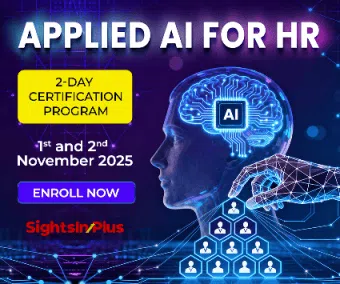“Ping, Survey, Repeat” How to Beat Engagement (Survey) Fatigue with the Human Touch?
This article focuses on Engagement Fatigue in the Digital era powered by AI, with a strong emphasis on Human-in-the-Loop (HITL) systems with real-world use cases to illustrate how HR can navigate and humanize tech-driven engagement.
As AI tools are soon captivating in-and-around workplaces, the engaged workforce is moving to another level, where it’s becoming more measurable, more frequent, and more automated than ever before.
The organizations want to know more and more through real-time feedback tools, pulse surveys, always-on sentiment trackers, pinging chatbots and the list seems endless.
Does More Always Mean It’s Better?
What started as a movement to include staff members in the conversation has now started to sound like constant background noise and a compulsive push. This is a new emerging workplace challenge (initiated during covid era), and now has a terminology to it – Engagement Fatigue (also referred to as Survey Fatigue).
What’s Engagement Fatigue?
Engagement fatigue is a growing intangible phenomenon where staff members may feel or become numb, insensitive, or indifferent to the constant influx of digital feedback-seeking triggers.
These are the same mechanisms that once made them feel heard, while are now making them feel hounded and suffocated. In other words, our approach is getting dated.
How Do Staff Members Feel or Act?
- Another tick in the box, where seeking views feels automated, but not authentic.
- Skips feedback triggers or just close the popups without even reading them.
- No impact despite reminders leading to a steady drop in the participation rates.
- Lack of concrete action on the feedback provided.
The very systems designed to enhance engagement and act as listening tools are now at the risk of eroding it’s purpose.
But this is not a tech problem – it’s a design problem. It will not get solved by simply turning off the digital tools, however, by reintroducing the human touch.
Enter HITL: Human-in-the-Loop Engagement
Human-in-the-Loop (HITL) systems help combine the efficiency of AI with the crucial emotional intelligence and contextual judgment of humans. So, AI supports it while humans guide the narrative and help make HR-related decisions. It’s like asking Humans to work with the digitally abled tools, where these AI tools are like young adults who still need guidance and direction.
What Does HITL In Engagement Mean Along With Using AI?
AI flags a team’s dropping sentiment scores, it identifies patterns in open-ended feedback or suggest optimal times for check-ins and so on. But it’s the humans who will get precise to interpret, act, and connect.
Below are few use cases where HR can strategically deploy HITL to beat engagement fatigue with human-touch and bring real meaning back to feedback mechanisms.
Use Case 1: From Survey Overload to Strategic Listening
The Problem: Staff members are bombarded with too many feedback requests: weekly mood polls, monthly surveys, check-ins after every town hall. Over time, responses dwindle, and authenticity declines.
The HITL Solution: Let AI analyse participation trends, sentiment shifts, and content quality. Then, let HR practitioners decide when it’s time to pause, when to dive deeper, or when to follow up personally.
Example in Action: A retail chain used AI to track employee feedback across 100+ locations. One store showed high engagement drop despite no visible issues. The local HR partner, alerted by the platform, visited the site and uncovered an unspoken leadership conflict. A human conversation solved which no survey could.
Use Case 2: Recognition That Feels Real
The Problem: Recognition platforms are gamified but often feel shallow—auto-generated “kudos” flood inboxes, but few feel meaningful. Staff members begins to zone out.
The HITL Solution: Use AI to highlight who’s contributing based on project logs, peer mentions, or productivity markers, while let managers choose how and when to recognize them.
Example in Action: A software firm implemented a recognition tool integrated with project tracking. When AI flagged team members who completed high-impact work, managers received prompts to write personalized thank-you notes. Engagement with recognition posts went up 3x as they felt it real.
Use Case 3: Prioritizing Manager Conversations
The Problem: Automated engagement systems gave everyone equal nudges. But in reality, some staff members needed deeper connection – especially during change, stress, or burnout.
The HITL Solution: Use AI to analyse tone, behavioural changes (for example, reduced email response rates), and survey language, but have people leaders follow up with them directly.
Example in Action: A global consulting firm flagged disengagement trends in a project team after a major client transition. Instead of launching another survey, HR encouraged 1-2-1 conversations guided by AI-generated prompts. Staff members appreciated the personal check-ins and provided richer insights than any multiple-choice question could uncover.
Use Case 4: Pulse Surveys with Purpose
The Problem: Pulse surveys are often sent at rigid intervals, regardless of context or timing, making them feel disconnected from what’s actually happening at work.
The HITL Solution: Let AI suggest the ideal moments to send surveys, like after a project delivery, new policy implementation, or team restructuring, but let HR approve and tailor the content.
Example in Action: An e-commerce company started sending feedback forms only after key moments, like onboarding week, post-campaign, or manager changes. AI determined when engagement was likely to fluctuate. HR designed meaningful questions relevant to the event. Result? Survey response quality improved 45%.
HITL: Not Just a Tool, it’s a Mindset Shift
The true power of Human-in-the-Loop lies in its philosophy: Technology should inform, not dictate. Staff members should guide, not be sidelined.
In an era of digital-first HR, we must remember:
- AI is smart; humans are wise.
- Algorithms can detect; staff members can understand.
- Engagement isn’t a number; it’s a relationship.
By keeping humans in the loop, we ensure engagement stays rooted in trust, empathy, and relevance.
Practical Tips to Implement HITL in HR Engagement Space
- Setting a “Feedback Cadence,” Not a Calendar: Let the engagement cycles be fluid, guided by team events and readiness, and not just mechanised monthly check-ins.
- Creating an Engagement Council: Blend AI-generated insights with local HRBPs insights to discuss trends, themes and then finalize the next steps.
- Empowering Managers with AI Prompts: Train leaders to read insights, then follow up with personalized outreach and not just robotic nudges.
- A/B Test Communication Styles: Use HITL to fine-tune messages to make it authentic for different teams or cultures.
- Create ‘Feedback’ Holidays: Sometimes, silence is strategic. Declare a ‘no-survey’ period when “survey fatigue” signals seems visible.
Conclusion: Less Noise, More Meaning
We’re living in an age of intelligent systems, smart tools, and wannabe automated everything. But when it comes to engagement, more tech doesn’t mean more trust.
Staff members don’t want to be pinged more. They want to be understood better. By putting the human back in the loop, we restore what technology alone can’t offer: context, compassion, and connection.
We need to have cultures where staff members feel seen, heard, and valued. For real.
The future of engagement isn’t about asking more. It’s about listening better, with AI as our compass, and humanity as our true self.
Note: We are also on WhatsApp, LinkedIn, and YouTube to get the latest news updates. Subscribe to our Channels. WhatsApp– Click Here, YouTube – Click Here, and LinkedIn– Click Here.



